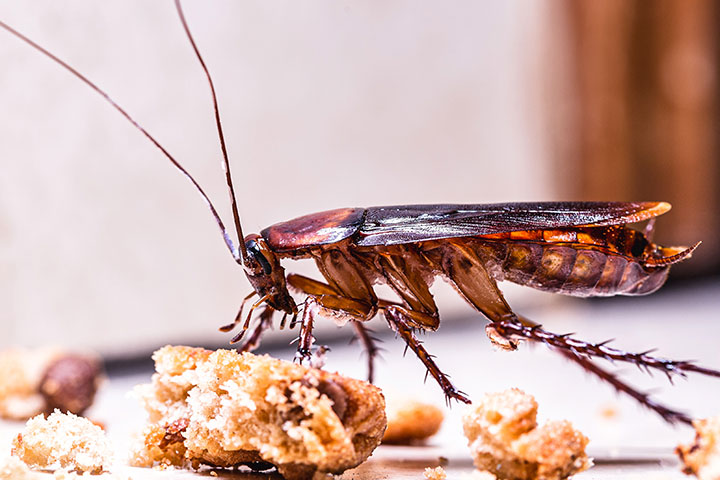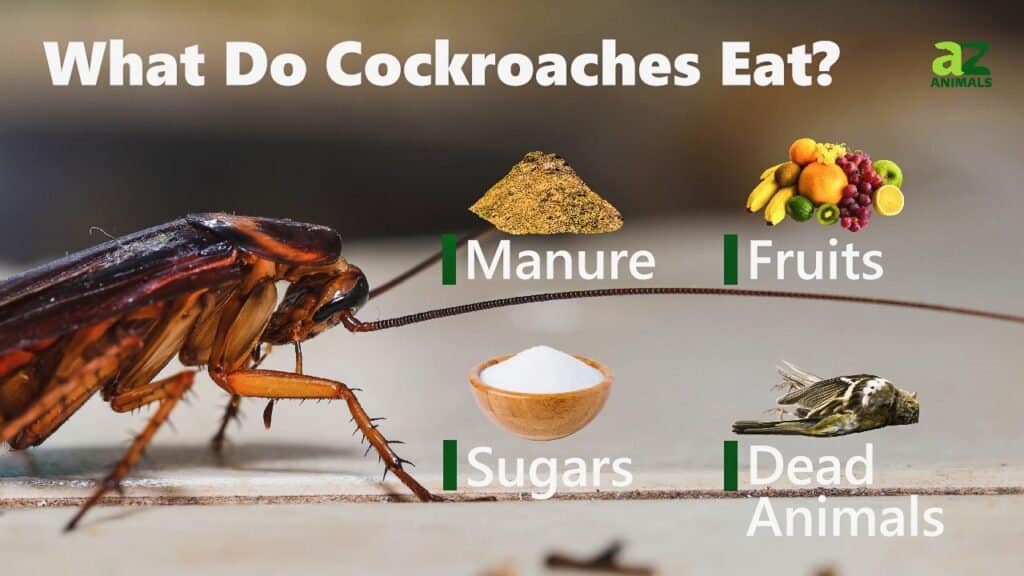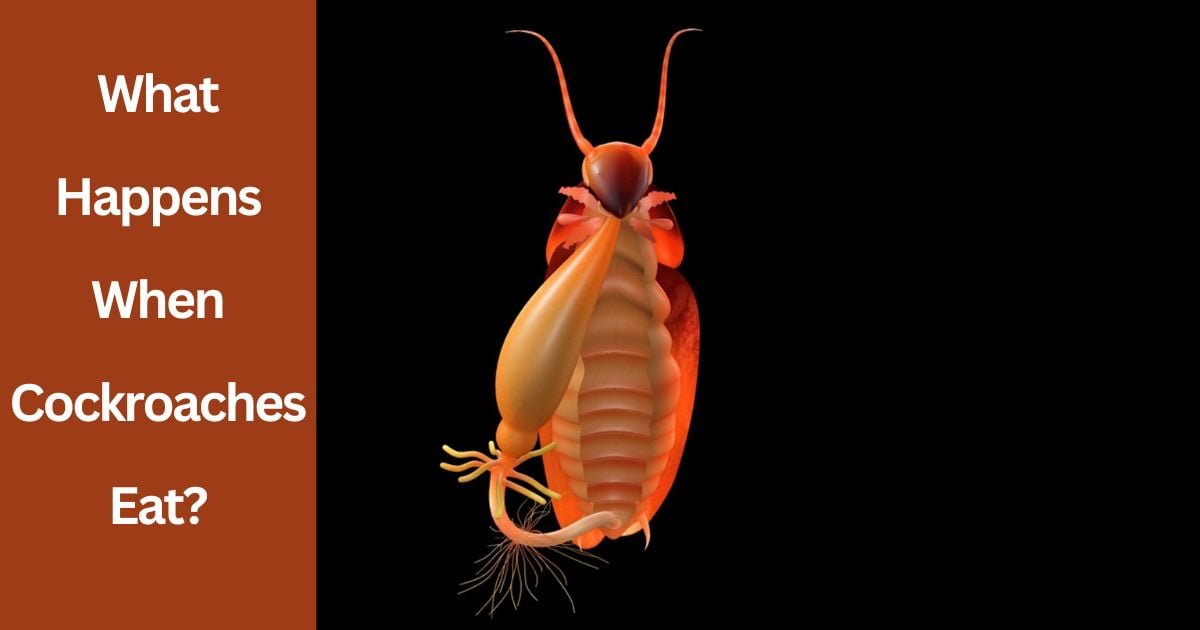When cockroaches eat, they digest the food in their gut, breaking it down for nutrition. Cockroaches can eat almost anything, including leftover food, paper, glue, and even book bindings.
They are attracted to starchy, sugary, and protein-rich foods, as well as grease and cheese. Cockroaches have the ability to spread diseases since they can consume virtually anything, from food spills to fecal matter. Ingested bacteria can survive in their digestive system and may be passed on through their droppings.
It is essential to keep food stored properly and maintain good hygiene to prevent cockroach infestations, as they can pose health risks by contaminating food and surfaces. Taking measures to eliminate their food sources and maintain a clean environment is crucial in keeping these pests at bay.
Body Parts And Functions
When cockroaches eat, they can pick up bacteria, parasites, and other pathogens that pose health risks if consumed. It is generally not recommended to eat cockroaches due to these potential health hazards.
Understanding Cockroach Anatomy Cockroaches are fascinating insects with a complex anatomy that serves vital functions for their survival. When delving into the body parts and functions of cockroaches, it becomes evident how their capability to eat influences their overall behavior and sustenance. Let’s explore this further by understanding the role of food consumption in cockroaches’ anatomy. Understanding Cockroach Anatomy The Role of Food Consumption Cockroaches possess a highly efficient anatomy that enables them to consume and digest a wide range of food sources. Their sophisticated mouthparts, including mandibles for chewing, allow them to break down food particles effectively. Furthermore, their digestive system, composed of a foregut, midgut, and hindgut, plays a crucial role in processing and absorbing nutrients from the ingested food. 1. Mouthparts: Cockroaches have mandibles that aid in chewing food into smaller fragments for easier ingestion. 2. Digestive System: Their digestive system consists of a foregut, midgut, and hindgut, which collectively support the breakdown and absorption of nutrients from food. 3. Food Consumption: Cockroaches feed on a variety of substances, ranging from organic matter to decaying materials, making them resilient and adaptable scavengers. Cockroaches consume a diverse diet, including sugars, starches, meats, and greasy substances. They also exhibit a preference for certain odors and tastes, which influence their food-seeking behavior. This ability to adapt to different food sources is closely tied to their survival instincts, allowing them to thrive in various environments. In essence, the intricate anatomy of cockroaches, particularly their mouthparts and digestive system, is intricately linked to their foraging behavior, food consumption, and overall sustenance. Understanding the interplay between their body parts and food consumption sheds light on the remarkable adaptability and resilience of these notorious insects.

Credit: www.pestworldforkids.org
Impacts On Health
The impacts of cockroach consumption on health cannot be taken lightly. Cockroaches are known carriers of bacteria, parasites, and pathogens that can pose serious health risks if consumed. In this section, we will explore the health risks associated with cockroach consumption, as well as the concerns of second-hand poisoning.
Health Risks Associated With Cockroach Consumption
Cockroaches feed on a wide range of materials, including decaying matter, garbage, and sewage. As a result, they can pick up harmful bacteria such as Salmonella and E. coli, which are known causes of food poisoning. When cockroaches eat contaminated food, these bacteria can survive in their digestive systems for extended periods. If consumed, these bacteria can cause severe gastrointestinal infections and other health complications. It is essential to eliminate the risks associated with cockroach infestations to safeguard our health.
Second-hand Poisoning Concerns
Aside from the direct health risks, there is also the concern of second-hand poisoning when cockroaches come into contact with toxic substances. Cockroaches can inadvertently transfer poison onto surfaces as they traverse them. When this poison makes contact with our food, it can lead to potential poisoning if consumed. The danger is amplified if the entire cockroach is accidentally ingested. To prevent such risks, it is crucial to ensure proper food storage and maintain a clean environment free from cockroach infestations.
Preventive Measures
Cockroaches can be a nuisance in any home, but there are several preventive measures that you can take to keep them away. By understanding what attracts cockroaches and utilizing natural repellents, you can effectively deter these pests from invading your living space.
Natural Repellents For Cockroaches
There are several natural repellents that you can use to keep cockroaches at bay. Essential oils such as peppermint oil, cedarwood oil, and cypress oil are effective in repelling cockroaches. You can also use crushed bay leaves and coffee grounds, as cockroaches detest the smell of these substances. For a natural way to kill them, a combination of powdered sugar and boric acid can be effective.
Food Items That Attract Cockroaches
Cockroaches are attracted to a variety of food items, which makes it important to keep these items properly stored and sealed. Sugar is the most attractive substance to a cockroach, followed by starchy foods and meats such as hamburger, chicken, and turkey. Grease and cheese are also highly appealing to cockroaches, so it’s crucial to keep your kitchen clean and free of food spills.
Disease Transmission
When cockroaches eat, they can transmit diseases through their droppings and body parts. Cockroaches will eat almost anything, including food spills, feces, and organic matter. Ingested bacteria can survive in the cockroach’s digestive system, spreading diseases through their droppings. Preventing their access to food sources is crucial for avoiding disease transmission.
Role Of Cockroaches In Disease Spread
Cockroaches are not just unsightly pests; they also play a significant role in the spread of diseases. These resilient creatures have an omnivorous diet, which means they can consume almost anything, including decaying matter, garbage, and even faecal matter. With their ability to survive on such a wide range of food sources, cockroaches often find themselves in contact with harmful bacteria and parasites. As they scuttle across your kitchen countertops and dining areas, they can leave behind a trail of contaminated surfaces, making disease transmission a significant concern.
Long-term Effects Of Ingested Bacteria
When cockroaches consume bacteria, such as Salmonella or E. coli, these pathogens can survive within their digestive system for months or even years. As a result, the cockroach becomes a carrier for these harmful bacteria, capable of transmitting them through their droppings and secretions. If a cockroach happens to crawl across your dinner plate or food preparation surfaces, it can leave behind these bacteria, increasing the risk of contamination. Ingesting food or water contaminated with these pathogens can lead to a range of illnesses, including gastrointestinal infections, food poisoning, and even respiratory issues. To protect yourself and your family from the potential health risks associated with cockroach infestations, it is crucial to practice good hygiene habits and maintain a clean living environment. Regularly clean your kitchen surfaces, dispose of garbage properly, and seal any cracks or gaps that may serve as entry points for these pests. Additionally, consider implementing natural cockroach deterrents, such as peppermint oil or powdered sugar and boric acid, to keep these unwanted guests at bay. In conclusion, understanding the role of cockroaches in disease transmission is essential for ensuring a healthy and safe living environment. By taking proactive measures to eliminate cockroach infestations and mitigate their presence, you can reduce the risk of contracting illnesses associated with these pests. Remember, prevention is the key when it comes to cockroach control, and maintaining a clean and hygienic home is the best defense against disease transmission.
Myths Vs. Facts
Cockroaches eating can spread diseases due to bacteria in their digestive system, posing health risks. Consuming contaminated food can result in food poisoning and health hazards. Cockroaches are attracted to sugar, starch, meat, and grease, making proper sanitation crucial to prevent infestations and health issues.
Debunking Common Misconceptions About Cockroaches
Cockroaches are often associated with various myths and misconceptions that have been passed down through generations. Let’s unravel the truth behind these beliefs.
Understanding Cockroach Behavior
By delving into the behavior of cockroaches, we can gain insight into their dining habits and how they can impact our environment. Let’s explore the facts.
Contrary to popular belief, cockroaches don’t just feast on leftovers or scraps. They are opportunistic feeders and consume a wide range of organic matter, including sugar, starch, meat, grease, and even cheese. These pests are attracted to a variety of food sources, making it essential to maintain a clean environment to deter them.
Although it’s a common misconception that cockroaches only thrive in unsanitary conditions, they can also infest clean spaces. Their ability to survive on minimal resources and adapt to different environments makes them a resilient pest.
- Myth: Cockroaches only inhabit dirty environments.
- Fact: Cockroaches can infest clean areas and survive on a variety of food sources.
Furthermore, the presence of cockroaches poses health risks due to the potential transmission of diseases. These insects can ingest and harbor pathogens in their digestive system, which may be transferred to humans through contact with contaminated surfaces or food.
When it comes to combating a cockroach infestation, understanding their behavior and dietary preferences is crucial. By implementing proper sanitation practices and sealing off entry points, you can mitigate the risk of an infestation and protect your home from these resilient pests.
Credit: www.quora.com
Cultural Perspectives
Exploring the varying attitudes toward eating cockroaches in different cultures sheds light on the intriguing cockroach consumption practices prevalent worldwide.
Attitudes Toward Eating Cockroaches In Different Cultures
In some cultures, eating cockroaches is viewed as a delicacy or a source of nutrition. The practice may be tied to traditional beliefs or as a means of survival.
Cockroach Consumption Practices
Some cultures incorporate cockroaches into cuisine, using them in stir-fries or as a protein-rich ingredient. Others utilize them for their purported medicinal properties.

Credit: a-z-animals.com
Frequently Asked Questions
What Happens If We Eat Cockroaches?
Eating cockroaches can be unsafe due to bacteria and parasites they carry, posing health risks.
Is It Safe To Eat Food If A Roach Was On It?
It is not safe to eat food if a roach was on it due to the risk of consuming bacteria, parasites, and pathogens carried by roaches, posing potential health hazards.
What Do Roaches Hate?
Roaches hate peppermint, cedarwood, and cypress oils, crushed bay leaves, coffee grounds, powdered sugar, and boric acid.
Conclusion
It’s best to avoid eating cockroaches due to the potential health risks they pose. These pests can carry bacteria and pathogens that are harmful to human health. It’s important to keep a clean environment to prevent these unwanted insects from entering our food sources.
Using natural deterrents can help in keeping cockroaches at bay.
Related posts:

I’m MD Tanvir, and I bring years of expertise gained from working closely with pest control companies to the forefront. My journey in the industry has inspired me to launch Bug Battler, a platform aimed at equipping people with the know-how to combat pests autonomously. Through Bug Battler, I aim to empower individuals with practical insights to tackle pest infestations effectively.

